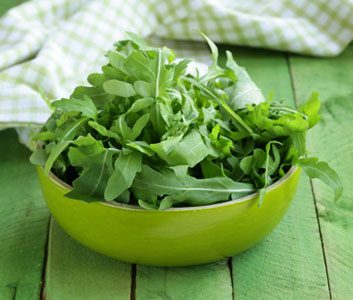
High-fibre and antioxidant-rich vegetables
Examples:
- Arugula, Bell peppers, Bok choy, Cabbage (green, purple), Cucumbers, Eggplants, Green beans, Kale, Lettuce, Parsnips, Potatoes, Radishes, Spinach, Summer squash, Sweet potatoes (up to 1/2 cup [125 mL] serving), Swiss chard, Tomatoes
All veggies are good for you: They are high in vitamins, minerals, phytonutrients, antioxidants and fibre, and they are generally low in calories and low in fat. But some vegetables do contain rapidly fermentable carbs that are difficult for some people to digest. The vegetables listed here are low in these carbs and rich in anti-inflammatory magnesium and other important minerals.
Standouts in this category are leafy green vegetables such as spinach, and especially kale and Swiss chard. Kale contains more than 45 different antioxidants, many with anti-inflammatory properties. It is also rich in vitamin C, which not only combats inflammation but, as shown in a study of 20 obese adults, can trim body mass and waist circumference. As for Swiss chard, it contains syringic acid, which has received special attention in recent research because of its ability to help stabilize blood sugar. This helps prevent the cravings that lead to overeating and weight gain.
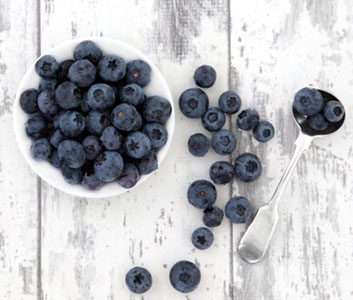
Balanced-fructose fruit
Examples:
Bananas, Blueberries, Cantaloupes, Cranberries, Grapes, Honeydew, Kiwis, Lemons, Limes, Oranges, Papayas, Pineapples, Raspberries, Star fruit, Strawberries
Fruit is bursting with antioxidants, fibre and other healthful ingredients. That said, some fruits are better for our GI system than others. (Fruit such as apples, mangoes, pears and watermelon are high in fructose, which for some people can contribute to gas, bloating and diarrhea.) The ones listed have a balanced glucose-to-fructose ratio, which may be easier on your digestive tract than those with excess fructose.
Standouts in this category are bananas and blueberries. Bananas are packed with filling fibre; they are also rich in anti-inflammatory magnesium, as well as vitamin B6 (which helps even out blood sugar). As for blueberries, they are high in fibre, are filling and relieve constipation. They also contain phytonutrients, including anti-inflammatory anthocyanins, tannins and other antioxidants.
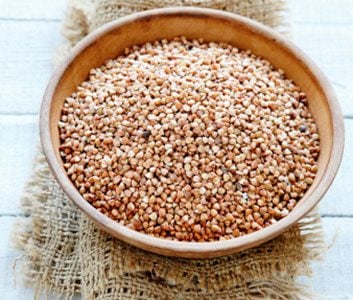
Certain grains
Examples:
Brown rice, Buckwheat, Oat bran, Oats (whole), Polenta, Quinoa, Rice bran
What do these grains all have in common? They are low in FODMAP carbs. What the heck are those, you say? Fermentable oligosaccharides, disaccharides, monosaccharides and polyols-or, more succinctly, rapidly fermentable carbs. Almost all grains are carb-dense and therefore may be bad for your stomach, especially in the quantities many of us are used to eating them. But they are also a great source of belly-friendly fibre, so stick to those that are low in FODMAPs and high in fibre, such as quinoa and oats. If you have a sensitive GI system, avoid wheat, barley and rye.
Quinoa (technically not a grain but a seed) contains just 21 grams of carbs per 100 grams, making it truly carb-light. It is also high in fibre and protein, both of which make it a satisfying super-food. Oats are another high-fibre, relatively carb-light favourite. According to a 2012 study, oats contain a type of sugar called beta-glucans, which are good for appetite control and glucose control. Stick with whole oats or oat bran, which are good sources of fibre, protein, essential fatty acids and vitamins.
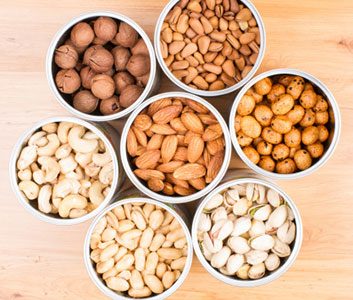
Nuts and nut butters
Examples:
Almonds (serving of up to 10 nuts, or 1 tablespoon [15 mL] nut butter), Hazelnuts (serving of up to 10 nuts, or 1 tablespoon [15 mL] nut butter), Macadamia nuts, Peanuts, Pecans, Pine nuts, Walnuts
Nuts contain protein, unsaturated fats, dietary fibre, vitamins and minerals-all jammed into a tiny, portable and delicious package. The mix of protein, fat and fibre makes nuts a great source of sustained energy. They are also great sources of monounsaturated fatty acids, which have been shown to target visceral (belly) fat. They are an excellent choice for a healthy tummy.
Peanuts, in particular, are high in anti-inflammatory magnesium; one ounce (30 g) of peanuts contains 50 milligrams. (Go unsalted to avoid bloat-inducing sodium.) When buying nut butters, get the all-natural types that don’t have hydrogenated fats. If it looks like it needs a good stir because the oil is sitting on top, it’s probably a natural product, and that’s a good thing.
However, certain nuts, such as pistachios and cashews, are high in sugars called galacto-oligosaccharides-which, for some people, are hard to digest.
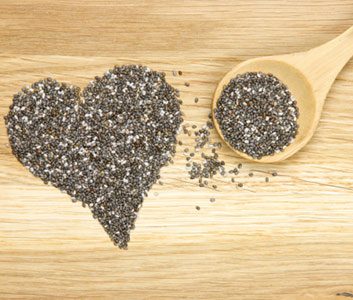
Seeds
Examples:
Chia seeds, Flaxseeds, Pumpkin seeds, Sesame seeds, Sunflower seeds
Like nuts, seeds are great sources of low-fermentable fibre and anti-inflammatory fats along with satiating protein. They are also rich in antioxidants that can protect against cell damage from chronic inflammation.
Chia, pumpkin and flaxseeds, for instance, all contain anti-inflammatory magnesium and omega-3 fatty acids. Chia seeds provide calcium. (One ounce [30 g] of chia seeds has more calcium than half a glass of milk!)
Pumpkin seeds-tasty both raw and roasted-are high in glutamate; this helps your body manufacture GABA, a brain chemical that reduces stress. Flaxseeds contain lignans, a type of phytochemical that may help protect against certain cancers. Whole flaxseeds pass through your body undigested, so be sure to either buy ground flaxseeds or grind your own with a coffee grinder.
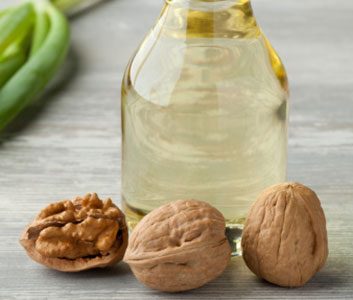
Healthy fats
Examples:
Omega-3 fatty acids: Canola oil, Flaxseeds and flaxseed oil, Herring, Mackerel, Salmon, Sardines, Soybean oil, Tuna, Walnuts and walnut oil, MUFAs: Avocados (serving of up to 1/8 avocado), ?Dark chocolate, Nuts and seeds, Olives and olive oil, Sesame oil
There are some fats we should be eating less of, such as trans fats and saturated fats, because they are linked to inflammation. But there are two kinds of fats in particular that we should be eating more of: omega-3 fatty acids, and monounsaturated fatty acids (MUFAs).
There are three types of omega-3 fatty acids: alpha-linolenic acid (ALA), eicosapentaenoic acid (EPA) and docosahexaenoic acid (DHA). We get EPA and DHA mostly from fish, while ALA can be found in some plant oils, such as flaxseed oil and walnut oil.
MUFAs may reduce “bad” cholesterol levels and maintain or increase “good” cholesterol. They can also target dangerous visceral (belly) fat. A 2007 study at the Reina Sofia University Hospital in Spain observed a group of overweight individuals who were put on different diets. While they all ate the same number of calories per day, the group that consumed the most MUFAs lost the most belly fat. Just remember that because fats are high in calories, you’ll want to keep servings relatively small.
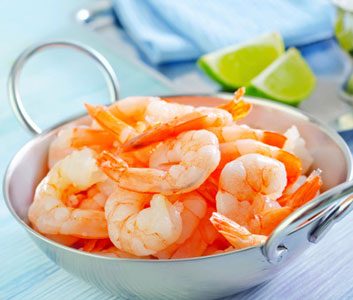
Lean protein
Examples:
Eggs, Fish (especially those high in omega-3 fats), Lean cuts of beef (such as flank steak and tenderloin), Lean cuts of pork (such as centre cut chops and tenderloin), Poultry (such as skinless white-meat chicken and turkey), Seafood (shrimp, lobster, clams, mussels, crab and oysters), Tofu, Tempeh
Protein has been shown to help you feel full longer, so you end up eating less throughout the day. In addition, protein provides your body with the building blocks to create muscle during workouts. Since your muscles burn calories even while you’re at rest, the more muscle you have, the more calories you burn.
Protein is carb-light and usually doesn’t pose any problems to digest (gluten, a protein found in wheat, is an exception for some people). Choose lean protein sources, though; many sources contain a lot of pro-inflammatory saturated fat.
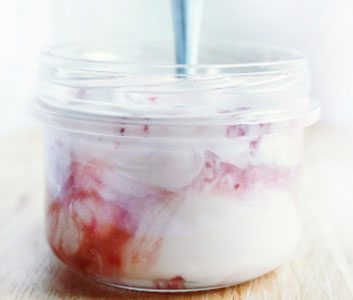
Greek yogurt
All yogurts are good sources of calcium, protein, zinc, and vitamins B6 and B12. In a 12-week study, researchers at the University of Tennessee showed that participants who replaced some foods with yogurt lost more body fat and had a “markedly greater reduction in waist circumference” with “trunk [abdominal] fat loss augmented by 81 percent in the yogurt versus the control group.” Greek yogurt has twice the protein content of regular yogurt and is lower in lactose, a plus for anyone who might be lactose-intolerant, a condition that causes bloating and digestion problems.
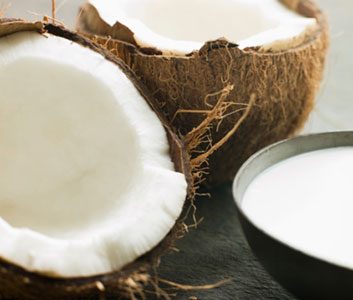
Coconut milk
More than half the fats in coconuts are medium-chain triglycerides (MCTs), which are more easily digested and therefore less likely to be stored as body fat. Coconut milk is a great lactose-free alternative to regular milk if you have to avoid dairy; it provides an excellent mix of fat, vitamin E and many other nutrients. Coconut milk can also help stabilize blood sugar and combat inflammation. Avoid products that have added sugar and, because coconut milk is high in fat, go for low-fat or light versions and limit yourself to a serving of ¼ cup (60 mL).
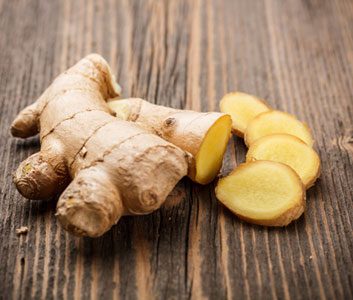
Ginger
Ginger is an anti-inflammatory and strengthens the muscle movements of your GI tract. In a double-blind study, 24 volunteers took either ginger tablets or a placebo. Results showed that the stomach emptied more quickly among those who took the ginger tablets.
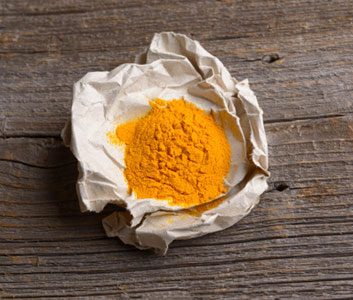
Turmeric
Turmeric, used in Indian curry, is a powerful antioxidant and may help fight infections and reduce inflammation. Research suggests it stimulates the gallbladder to produce more bile, which may improve digestion.
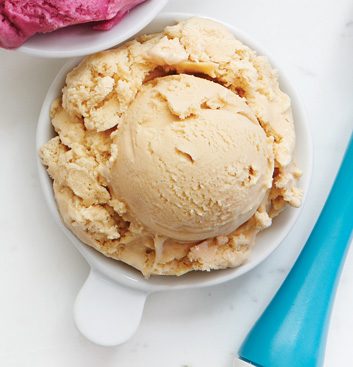
Maple syrup
Have a sweet tooth? Try maple syrup, in moderation: It has the lowest amount of fructose of its fellow sweeteners (honey and agave nectar are both high in excess fructose, which can irritate the GI tract and contribute to gas, bloating and diarrhea).
Related:
• 10 delicious dishes for a happy belly
• The worst foods for bloating
• 7 ways to beat belly bloat
